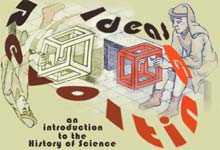
University of California, Irvine
Instructor: Dr. Barbara J. Becker

|
|
|
|
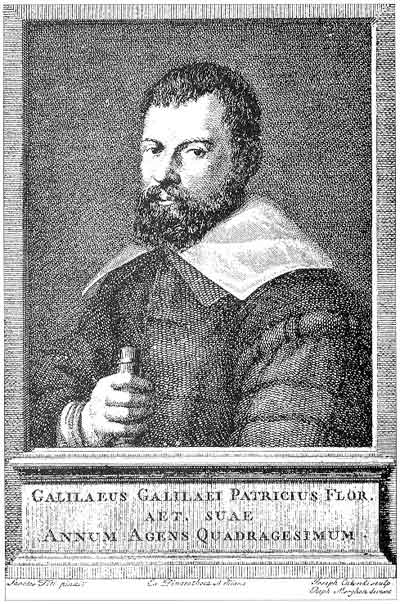
|
|
|
1564 |
born at Pisa |
1581 |
enrolled at University of Pisa as medical student |
1585 |
abandoned medicine for mathematics |
1589 |
took teaching post at Pisa |
1590 |
began writing down his thoughts on motion |
1592 |
took position as professor of mathematics at University of Padua
earned money selling gadgets and serving as military consultant |
1605 |
served as mathematics tutor to Cosimo de' Medici |
1609 |
Cosimo became Grand Duke of Tuscany |
1610 |
published Sidereus Nuncius [Starry Messenger]
-resigned post at Padua -took position of "Chief Mathematician and Philosopher" to Grand Duke Cosimo II |
|
Revealing great, unusual, and remarkable spectacles, opening these to the consideration of every man, and especially of philosophers and astronomers; AS OBSERVED BY GALILEO GALILEI
WITH THE AID OF A
lately invented by him, In the surface of the Moon, in innumerable Fixed Stars, in Nebulae,
in FOUR PLANETS swiftly revolving about Jupiter at differing distances and periods,
and known to no one before the Author recently perceived them and decided
that they should be named
Venice
To the Most Serene
...scarce have the immortal graces of your spirit begun to shine on earth when in the heavens bright stars appear as tongues to tell and celebrate your exceeding virtues to all time. Behold, then, four stars reserved to bear your famous name; bodies which belong not to the inconspicuous multitude of fixed stars, but to the bright ranks of the planets.... ...Indeed, the Maker of the stars himself has seemed by clear indications to direct that I assign to these new planets Your Highness's famous name.... For just as these stars, like children worthy of their sire, never leave the side of Jupiter ... so clemency, kindness of heart, gentleness of manner, splendor of royal blood, nobility in public affairs, and excellency of authority and rule have all fixed their abode and habitation in Your Highness.... |
|
|
|
|
as Determined using a Modern Computer Planetarium Program (Redshift) |
 |
January 7, 1610 [T]wo stars were near [Jupiter] on the east and one on the west.... I was not the least concerned with their distances from Jupiter, for ... at first I believed them to be fixed stars.... |
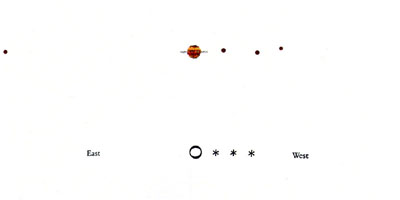 |
[O]n the eighth ... I found a very different arrangement. For all three little stars were to the west of Jupiter and closer to each other than the previous night.... I was aroused by the question of how Jupiter could be to the east of all the said fixed stars when the day before he had been to the west of them.... |
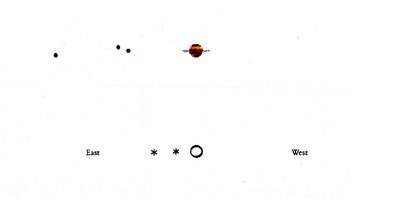 |
[O]n the tenth ... [o]nly two stars were near him, both to the east.... |
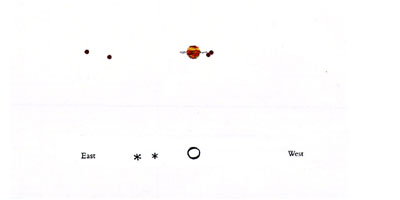 |
There were only two stars on the east, of which the middle one was three times as far from Jupiter than from the more eastern one.... I therefore arrived at the conclusion, entirely beyond doubt, that in the heavens there are three stars wandering around Jupiter like Venus and Mercury around the Sun.... |
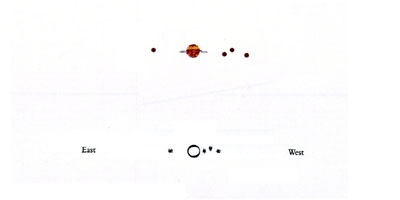 |
[F]or the first time four little stars were seen by me.... They formed a very nearly straight line, but the middle star of the western ones was displaced a little to the north from the straight line.... |
 |
[T]he four stars ... were all to the west and arranged very nearly in a straight line, except that the third one from Jupiter was raised a little bit to the north.... They were very brilliant and did not twinkle, as indeed was always the case.... |
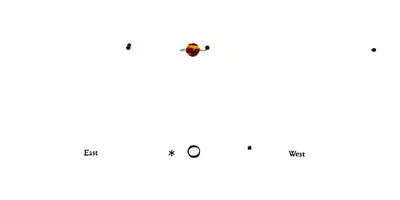 |
On the seventeenth, 30 minutes after sunset, the configuration was thus. There was only one star on the east, 3 minutes from Jupiter. Likewise, one was 11 minutes from Jupiter to the west. The eastern one appeared twice as large as the western one. There were no more than these two.... |
 |
...But after 4 hours ... on the eastern side a third began to emerge, which, I suspect, had earlier been united with the first one.... |
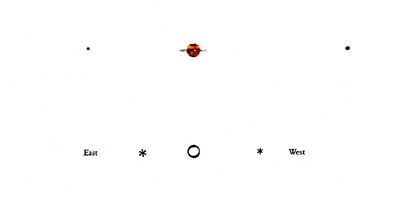 |
On the eighteenth ... [t]he eastern star was larger than the western one and 8 minutes distant from Jupiter, while the western one was 10 minutes from Jupiter. |
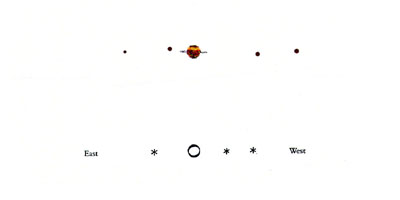 |
There were three stars exactly on a straight line through Jupiter.... At this time I was uncertain whether between the eastern star and Jupiter there was a little star, very close to Jupiter, so that it almost touched him. |
|
by Thomas Hariot (c. 1560-1621)
|
|
|
A moving earth required a new physics. A new physics required--
Does the intellectual, political, social, economic climate of a time provide a "script" for individuals to play out? If not Galileo, would someone else have stepped in to meet the challenges imposed by Copernicus' strange new heliocentric plan? |
|
|
|
|
The Grand Duchess Christina of Lorraine (1565-1637) was the granddaughter of Catherine de' Medici. When her husband, Ferdinand de' Medici died in 1609, their eldest son, Cosimo (1590-1621)--whom Galileo had tutored in mathematics just a few years before--became the new Grand Duke of Tuscany. In 1610, Galileo dedicated his new book, Sidereus Nuncius, to Cosimo II, and named the four newly discovered satellites of Jupiter the Medicean stars in honor of Cosimo and his three brothers. Unfortunately, Cosimo became ill and died in 1621. Cosimo's mother, Christina, and his widow, Maria Maddalena of Austria, served as regents for the new Grand Duke, young Ferdinand II (1610-1670).
Benedetto Castelli (1578-1643), a monk, was perhaps Galileo's favorite student. In December 1613, Castelli, the newly appointed chair of mathematics at the University of Pisa, was invited to breakfast with the Tuscan court . Here's how he described his experience in a letter (December 14, 1613) to Galileo:
|
|
Galileo composed a lengthy response (December 21, 1613) to Castelli. In it, he expressed his concern that theologians, ignorant of basic astronomical principles, risked compounding their errors through misinterpretation of Holy Scripture and misapplication of its authority to problems in natural philosophy:
In 1615, Galileo wrote a lengthier and more detailed version of this letter which he addressed to the Grand Duchess Christina herself. His letter to Castelli, meanwhile, was privately circulated. But it eventually came to the attention of some of Galileo's enemies. In February 1615, a Dominican friar, Niccolò Lorini, sent a copy of Galileo's letter to Rome as evidence of his heresy, prompting the authorities of the Inquisition to call Galileo in for questioning and admonishment. |
Notable Events in Galileo's Life (cont'd) |
|
1615 |
Galileo wrote letter to the Grand Duchess Christina |
1616 |
Copernican theory condemned by Church
Galileo told to stop teaching it |
|
|
|
12. Then spake Joshua to the Lord in the day when the Lord delivered up to the Amorites before the children of Israel, and he said in the sight of Israel, Sun, stand thou still upon Gideon; and thou, Moon, in the valley of Ajalon. 13. And the sun stood still, and the moon stayed, until the people had avenged themselves upon their enemies. Is not this written in the book of Jasher? So the sun stood still in the midst of heaven, and hasted not to go down about a whole day. 14. And there was no day like that before it or after it, that the Lord hearkened unto the voice of a man: for the Lord fought for Israel. Ecclesiastes 1:5-9 5. The sun also riseth, and the sun goeth down; and hasteth to his place where he arose. 6. The wind goeth toward the south, and turneth about until the north; it whirleth about continually, and the wind returneth again according to his circuits. 7. All the rivers run into the sea; yet the sea is not full; unto the place from whence the rivers come, thither they return again... 9. The thing that hath been, it is that which shall be; and that which is done is that which shall be done: and there is no new thing under the sun. |
|
|
|
||
Every day, according to Ptolemy, the Sun appears to be carried around the Earth from East
to West by the sphere of the fixed stars.
Like a stationary passenger whirling around on a merry-go-round or carried down by an escalator, the setting Sun appears to follow a path parallel to the celestial equator. But, in Ptolemy's system the Sun also moves on its own -- every day it slowly shifts its position from West
to East against the background stars in its yearly
trip around the ecliptic.
Depiction of the sun's "proper motion" along the ecliptic over a period of several days.
Like a person walking up a down escalator, the Sun appears to plod from west to east along the ecliptic (Circle of the Different) against the persistent daily motion (Circle of the Same) of celestial objects from east to west. |
||
According to Galileo:
|
|
Notable Events in Galileo's Life (cont'd) |
|
1623 |
Cardinal Maffeo Barberini became Pope Urban VIII |
1625 |
Galileo began writing a defense of Copernican theory (future Dialogue...) |
1632 |
published Dialogue Concerning the Two Chief World Systems; written
in colloquial Italian, not Latin
Galileo ordered to stand trial |
1633 |
placed under house arrest |
1635 |
Dialogue... translated into Latin and English |
1636 |
letter to Grand Duchess Christina published in Italian and Latin | 1638 |
Discourses and Demonstrations Concerning Two New Sciences published at Leyden -- a handbook for those who wish to learn the language and methods of the new physics |
|
|
|